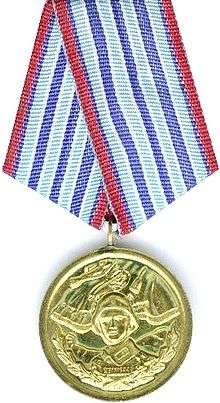Bulgarian People's Army
| Bulgarian People's Army | |
|---|---|
| Bulgarska Narodna Armiya | |
.svg.png) | |
| Motto |
"за нашата социалистическа родина!" Za nashata Soshtialistcheska rodina! (For our socialist motherland!) |
| Founded | 1952 |
| Disbanded | 1990 |
| Service branches |
|
| Headquarters | Sofia |
| Leadership | |
| Minister of People's Defense |
See list
|
| Chief of Defense | Hristo Dobrev |
| Manpower | |
| Conscription | Yes |
| Active personnel | 320,000 (1989) |
| Deployed personnel |
|
| Industry | |
| Foreign suppliers |
"Former" |
| Related articles | |
| History | Warsaw Pact invasion of Czechoslovakia |
The Bulgarian People's Army (BNA) (Bulgarian: Българска народна армия) was the military of the People's Republic of Bulgaria (PRB).
It comprised the Bulgarian Land Forces, Air Force and Air Defence, Naval Fleet and supporting arms. Bulgaria was one of the signatories of the Warsaw Pact. Along with troops form other Warsaw Pact countries, the BNA participated in the Warsaw Pact invasion of Czechoslovakia in 1968. However, other than this, the BNA did not see any combat during its existence. The Bulgarian People's Army dissolved along with the People's Republic of Bulgaria in 1990 and was succeeded by the Bulgarian Armed Forces.
History
The People's Republic of Bulgaria formed the BNA on September 8, 1944 after the Soviet Union invaded Bulgaria and installed the communist government.[1] In 1952 it was officially named the Bulgarian People's Army. In the period between 1948 and 1952 it was involved in repelling attacks by the Greek Army. It joined the Warsaw Pact on May 14, 1955 and activities in the alliance include the Warsaw Pact Invasion of Czechoslovakia. On October 23, 1968, the 22 Artillery Regiment that invaded the country withdrew from Czechoslovakia. It advised North Korea in the Korean War and provided medical assistance to the troops of the DPRK.[2] It also advised the Viet Cong during the Vietnam War. During the 1950s, 60s and 70s the BNA assisted countries like Algeria, Yemen, Libya, Iraq, Nicaragua, Egypt, and Syria as well as taking part in action in Afghanistan in the 1980s.[3]

Composition
The BNA's manpower by the time the Peoples Republic was dissolved reached 120,000 men most who were conscripts. The combined strength of the Army, Navy, Air Force, Air Defense Forces, Missile Forces, plus the strength of the Peoples Militia and the Border Troops reached 150,000 in 1988.[4]
Equipment
The equipment of the BNA was mostly equipment provided by the Soviet Union. Some of this equipment were 500 combat aircraft, 3,000 (mostly T-55) tanks, 2,000 armored vehicles, 2,500 artillery systems, 33 navy vessels, 67 Scud missiles, and 24 SS-23 rocket launchers.[5]
.svg.png)
Organization
The defense policy of the country was managed by the Ministry of the People's Defense (Министерство на Народната Отбрана (МНО), headed by a professional officer - an Army General or a Colonel general), under the direct supervision of the Bulgarian Communist Party. The Bulgarian People's Army (Българска Народна Армия (БНА)) had 3 main branches.
- Land Troops (Сухопътни войски (СВ), including the Missile Troops and Artillery (Ракетни Войски и Артилерия (РВА)))
- Air Forces and Air Defense (Военновъздушни Сили и Противовъздушна Отбрана (ВВС и ПВО))
- Naval Forces (Военноморски сили (ВМС))
Several other branches were directly controlled by the Ministry of National Defense.
- Border Troops (Гранични Войски (ГВ), at some times under the Ministry of the Interior)
- Interior Troops (Вътрешни войски (ВВ), under the Ministry of the Interior, disbanded in the 1960s, reestablished in the beginning of the 1980s in connection with the Revival Process and the terror attacks of the 1980s)
- Civil Defense Service (Гражданска Защита (ГЗ))
- Troops of the Postal and Distant-Messaging Committee (Войски на Комитета по Пощи и Далекосъобщения (ВКПД)) - the government communications troops, under military discipline, outside of Ministry of the People's Defense jurisdiction. The Committee is a ministry within the government.
- Troops of the Ministry of Transport (Войски на Министерство на Транспорта (ВМТ)) - transport and railway construction brigades under the Ministry of Transport, under military discipline, outside of Ministry of the People's Defense jurisdiction.
- Construction Troops (Строителни Войски (СВ) with the Labor Troops (Трудови войски (ТВ)) as their main arm), directly subordinated to the Ministry of the People's Defense.
- Peoples' Militia - the Socialist Era police force, the main arm of the Ministry of the Interior.
The combined strength of all of the forces was 325,000 in 1989.[6]

Structure of the Bulgarian People's Army 1989
See also
References
- ↑ "Bulgaria - Table A. Chronology of Important Events". www.country-data.com. Retrieved 2016-09-04.
- ↑ "Who was involved? | The Armed Forces in the Korean War | Australia's involvement in the Korean War". korean-war.commemoration.gov.au. Retrieved 2016-09-05.
- ↑ https://www.nytimes.com/1982/12/20/world/troops-of-5-soviet-allies-reported-fighting-guerillas-in-afghanistan.html
- ↑ "Bulgaria Armed Services - Flags, Maps, Economy, History, Climate, Natural Resources, Current Issues, International Agreements, Population, Social Statistics, Political System". www.photius.com. Retrieved 2016-09-25.
- ↑ "icweb2".
- ↑ "Bulgaria Armed Services - Flags, Maps, Economy, History, Climate, Natural Resources, Current Issues, International Agreements, Population, Social Statistics, Political System". www.photius.com. Retrieved 2016-09-16.